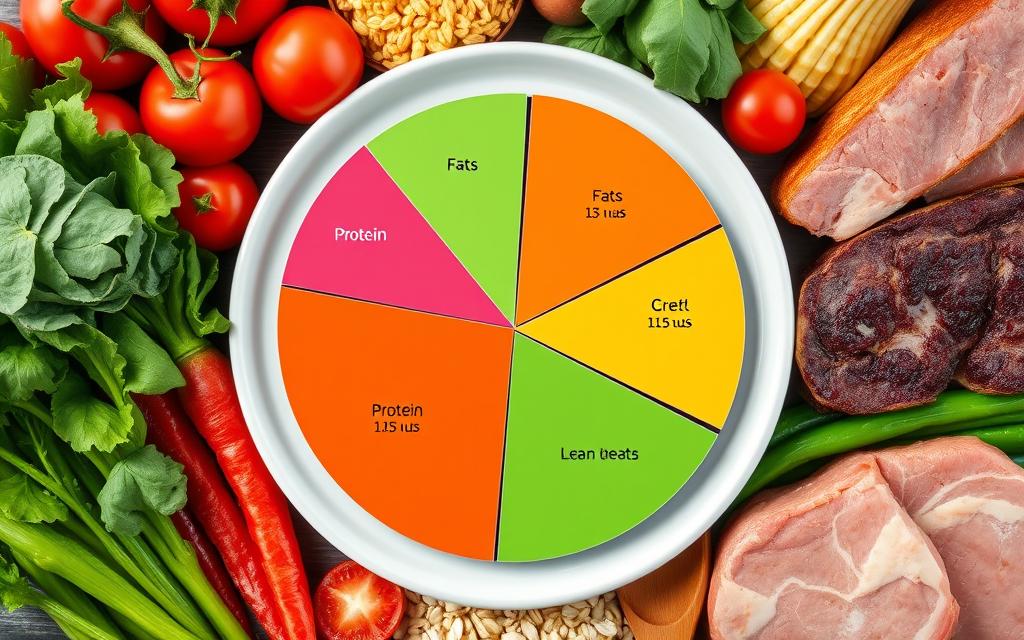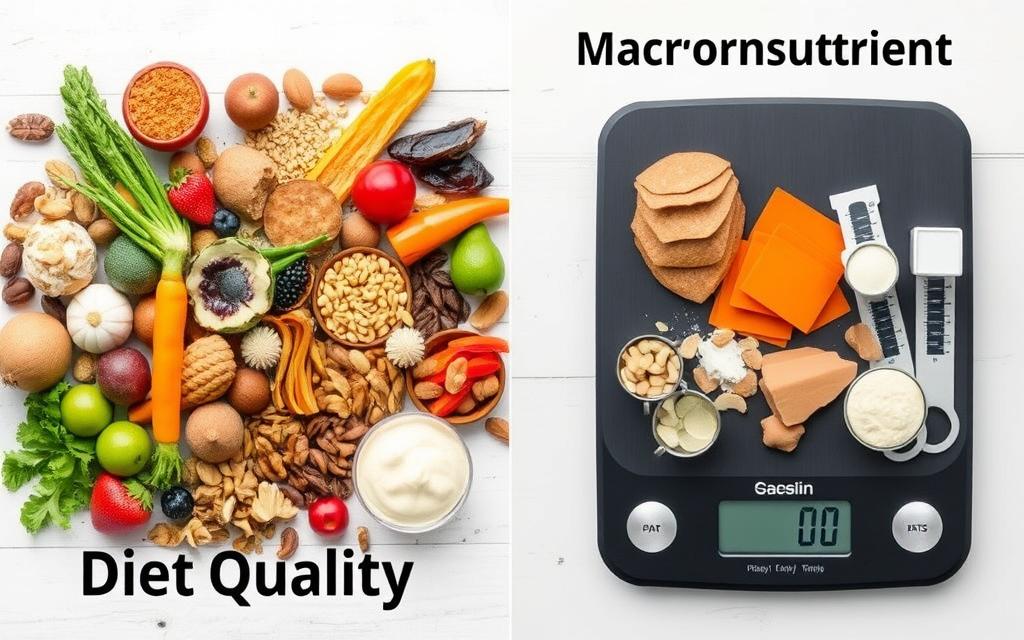Exploring nutrition can be tough. Standing in front of the grocery store, we wonder what foods are best. This macronutrient guide will cover proteins, carbs, and fats. It will show how they are key to our health.
Knowing about macronutrients helps us make better food choices. Every meal we eat can help our body and mood. Let’s learn about these important nutrients together.
Key Takeaways
- Macronutrients are essential nutrients—proteins, carbohydrates, and fats—needed in larger amounts.
- The body thrives on a balance of these nutrients to function optimally and maintain health.
- Understanding macronutrient ratios allows us to personalize our dietary needs effectively.
- Replacing processed carbohydrates with healthier options can facilitate weight loss and boost energy.
- Quality sources of protein play a significant role in various bodily functions, including immune support.
What Are Macronutrients?
Macronutrients are key nutrients our bodies need a lot of to work well. The main ones are carbohydrates, proteins, and fats. Each one has a special job for our health.
Carbohydrates give us energy, with 4 calories per gram. Proteins help our bodies grow and repair. Fats store energy and help with important body functions like making hormones1.
These big nutrients are more important than micronutrients like vitamins and minerals. We need them in larger amounts2.
How much we need changes based on our age, sex, and how active we are. The Dietary Guidelines say we should eat 45% to 65% of our calories as carbs. Proteins should be 10% to 35%, and fats 20% to 35%2.
Knowing about these nutrients helps us make healthier food choices. This way, we can reach our health goals.
Importance of Macronutrients for Health
Macronutrients are key to our diet. They give us energy and help build and repair our cells. Carbohydrates, making up 45–65% of our calories, fuel our brains and muscles during hard workouts3. Without enough carbs, our performance drops.
Proteins are also crucial. They make up a big part of our bodies and help with growth and repair. We should eat 10–35% of our calories as protein, based on our age and activity3. Eating enough protein keeps our muscles strong and our immune system healthy.
Fats are often misunderstood but are essential. They store energy and help with hormone production and vitamin absorption. We should get 20–35% of our calories from fats3. Eating healthy fats can greatly improve our health and well-being.
Studies show that eating the right mix of macronutrients is key to good health. For instance, eating less fat can lead to weight loss and better health over time4. By focusing on the health benefits of macronutrients, we can develop better eating habits for life.
Understanding Macronutrients and Their Functions
We often overlook the essential roles of macronutrients in our daily diets. Each macronutrient plays a specific role that contributes to our overall health and well-being. Carbohydrates break down into glucose, serving as our primary energy source. This is vital for our brains and physical activities.
Proteins, composed of amino acids, perform critical functions such as tissue growth and repair. They are instrumental in producing enzymes and hormones that regulate various bodily processes. Without adequate protein intake, we risk compromising our body’s ability to function effectively.
Fats are essential as well; they enable us to absorb fat-soluble vitamins and provide long-lasting energy reserves. They also support cell structure, playing a crucial role in maintaining healthy cell membranes. Understanding these macronutrient functions enables us to recognize the importance of balancing these nutrients in our diets.
Incorporating the right amounts of each macronutrient helps us promote optimal health and vitality. Balancing carbohydrates, proteins, and fats is necessary for maintaining energy levels and supporting bodily functions. This ultimately contributes to our overall health.
As we track our nutrition, it is essential to consider these functions and strategies for achieving a balanced diet. By doing so, we can ensure that we are meeting our body’s needs effectively5.
Macronutrient Breakdown: Carbohydrates
Carbohydrates are key in our diet, giving us energy and nutrients. They come in two types: simple and complex. Simple carbs, like sugars, give quick energy but can cause blood sugar spikes. Complex carbs, like starches and fiber, digest slower and keep blood sugar stable.
It’s important to know the difference to pick healthy carbs for our meals.
Types of Carbohydrates
Carbs are mainly simple and complex. Simple carbs, like sugars, give quick energy but can cause blood sugar spikes if eaten too much6. Complex carbs, on the other hand, digest slower and give steady energy while keeping us healthy6.
These can be broken down into:
- Soluble fiber – dissolves in water and can help lower cholesterol levels.
- Insoluble fiber – does not dissolve in water and aids in digestive health.
Complex carbs come from whole grains, legumes, fruits, vegetables, and nuts. Eating these is key for staying healthy and well.
Sources of Carbohydrates
Choosing the right carbs for our meals is important. The USDA suggests filling half our plate with fruits and veggies, one-quarter with whole grains, and another quarter with protein6. Foods high in fiber are great carbs and include:
| Food Sources | Type |
|---|---|
| Oats | Whole Grain |
| Beans | Legume |
| Berries | Fruit |
| Broccoli | Vegetable |
| Quinoa | Whole Grain |
Sugars are carbs, but they’re different. Naturally occurring sugars are in milk and fruits, while added sugars are in processed foods. The American Heart Association says to limit added sugars to 25 grams a day for women and 36 grams for men6
Macronutrient Breakdown: Proteins
Proteins are key to our diet, helping with many body functions. They help build and fix tissues and make enzymes and hormones. Our bodies need amino acids to work right; we can make 11 but must get 9 from food.
Role of Proteins in the Body
Proteins do more than just fix muscles. They help fight off infections, make hormones, and give energy when needed. Eating enough protein helps us get all the amino acids our body needs. The USDA says we should eat 10% to 35% of our calories as protein7.
Sources of Protein
We have many good protein sources to choose from. Some include:
- Meat and poultry
- Fish and seafood
- Eggs
- Dairy products (milk, yogurt, cheese)
- Beans and pulses
- Nuts and seeds
- Soy products (tofu, tempeh)
- Meat alternatives (e.g., Beyond/Impossible Burger, seitan)
Mixing different protein sources ensures we get all the amino acids we need. This variety also helps us absorb nutrients better and get more health benefits.
Integrating adequate protein sources into our meals is crucial for achieving our nutritional goals.
| Protein Source | Essential Amino Acids | Type |
|---|---|---|
| Chicken Breast | Complete | Animal |
| Lentils | Incomplete | Plant |
| Eggs | Complete | Animal |
| Quinoa | Complete | Plant |
| Greek Yogurt | Complete | Animal |
By eating a balanced mix of these protein sources, we keep our bodies healthy and working well7.
Macronutrient Breakdown: Fats
Fats are vital for our bodies, giving us energy and helping with hormone production. They also help us absorb nutrients. Knowing about different fats helps us make better food choices for our health.
Types of Dietary Fats
Fats fall into several groups:
- Saturated Fats: These are solid at room temperature and found in animal products and some oils. Research now questions their link to heart disease.
- Unsaturated Fats: These are liquid at room temperature and are healthier. Sources include olive oil, avocados, and oily fish. They’re good for heart health.
- Trans Fats: Created through hydrogenation, they raise cholesterol levels. The U.S. banned partially hydrogenated oils to cut down on these fats.
We should aim to eat healthy fats in our meals. This helps us meet our health goals.
Healthy Sources of Fat
Here are some healthy fat sources:
| Food Item | Type of Fat | Health Benefits |
|---|---|---|
| Nuts | Unsaturated | Rich in omega-3 fatty acids, beneficial for heart health. |
| Avocados | Unsaturated | High in fiber and potassium, supporting cardiovascular health. |
| Olive Oil | Unsaturated | Known for lowering cholesterol levels, which may reduce the risk of heart disease. |
| Fatty Fish (e.g., salmon, mackerel) | Unsaturated | High in omega-3 fatty acids, promoting brain function and reducing inflammation. |
| Full-Fat Dairy | Saturated | Provides essential nutrients, but moderation is key to balance. |
Adding these healthy fats to our diet brings many benefits. They support our health and well-being89.

Caloric Content of Macronutrients
Knowing the caloric content of macronutrients helps us manage our energy intake. Carbohydrates and proteins give about 4 calories per gram. On the other hand, fats pack a punch with 9 calories per gram101112. This big difference shows why it’s important to eat in moderation and balance.
Let’s say we eat 1,500 calories a day. We might split these calories among our macronutrients. This means 125 grams of protein (500 calories), 56 grams of fat (500 calories), and 125 grams of carbs (500 calories)1011. Knowing how each macronutrient gives energy lets us tailor our diets to our needs. For example, eating more protein can help keep muscle mass when we’re on a calorie-restricted diet12.
It’s also key to know how much energy we burn each day. If we want to lose weight, we need to eat fewer calories than we burn. On the flip side, to gain weight, we need to eat more calories101112.
Macronutrient Ratios: How Much Do We Need?
Knowing the right macronutrient ratios is key to good health and meeting our dietary goals. The USDA recommendations give us a good starting point. They tell us how much of our calories should come from carbs, proteins, and fats.
USDA Recommendations for Macronutrient Intake
The USDA recommendations say carbs should be 45-65% of our calories. Proteins should be 10-35%, and fats 20-35%13. For men, this means eating at least 56 grams of protein daily. Women should aim for 46 grams, based on the Dietary Guidelines for Americans 2020–202513.
For weight loss, eating 1.2-2 grams of protein per kilogram of body weight is recommended13.
Personalized Macronutrient Needs
While the USDA recommendations are helpful, our needs can vary. Our age, sex, activity level, and health conditions all play a part. For example, fats should be 20-35% of our daily calories for those 4 and older1314.

Grasping these ratios helps us make better food choices. It lets us create a diet that fits our health goals and lifestyle. Remember, nutrition is not one-size-fits-all. It should be tailored to each person’s unique needs.
| Macronutrient | Recommended Percentage | Calories per Gram |
|---|---|---|
| Carbohydrates | 45-65% | 4 kcal/g |
| Proteins | 10-35% | 4 kcal/g |
| Fats | 20-35% | 9 kcal/g |
How to Track Macronutrients
Tracking macronutrients is key to reaching our dietary goals. It helps us balance protein, carbohydrates, and fats. Knowing how to track macros lets us monitor our food intake well. This supports our health and fitness goals.
Mobile apps like MyFitnessPal are great for tracking macronutrients. They let us log our meals and see our macronutrient balance easily. Experts say carbs should be 45-65% of our calories, proteins 10-35%, and fats 20-35%15.
In a 2,000-calorie diet, this means 250 grams of carbs, 150 grams of protein, and 45 grams of fat16.
Digital tools like food scales and measuring cups help us track better. Changing our calorie intake is important for weight loss or muscle gain. For fat loss, we need a caloric deficit. For muscle gain, we need to eat more calories. It’s good to wait at least two weeks to see changes16.
Tracking macronutrients helps us understand our diet better. This leads to better food choices over time. It’s a step towards better nutrition and health.
Benefits of Understanding Macronutrients
Knowing about macronutrients is key to better health and well-being. By understanding the benefits of understanding macronutrients, we can make better food choices. This knowledge helps us plan meals that give us the energy we need.
Also, knowing about macronutrients boosts our metabolism and helps control hunger. This is important for managing our weight. But, too much tracking can stress us out and lead to unhealthy eating habits17.
Studies show that knowing how proteins and carbs work together can affect aging. This shows how important it is to know about nutrients18. Also, one in three people worldwide face diet-related problems, from obesity to vitamin deficiencies19. This highlights the need to understand macronutrients for personal and global health.
In the end, tracking macronutrients should be short-term, not a long-term goal. This way, we can have a healthier relationship with food and still enjoy the health benefits of making smart food choices.
Common Myths About Macronutrients
We often hear myths about macronutrients that lead to misconceptions about macros. One common myth is that eating fats will make us gain weight. But fats are key for our health and help us feel full, making it easier to control calories. Most fats, like unsaturated ones, are good for us.
Another myth is that we should cut out carbs to lose weight. But carbs are our main energy source for sports and are essential for energy. Studies show that not enough carbs can hurt our performance in long sports, so we need enough carbs to do well20.
Many think protein only matters right after working out. But our muscles keep building for up to 24 hours after exercise. A big study found that eating protein before and after working out is best2122. Also, our muscles can take in 25 to 35 grams of protein at a time, showing that eating protein often is good22.
Lastly, research shows that low-carb and low-fat diets don’t really differ in weight loss after a year20. This means focusing on diet quality and balance is more important than strict macronutrient rules. Eating a variety of macronutrients is best for our health.
Diet Quality vs. Macronutrient Counting
In our quest for better health, we often debate diet quality versus macronutrient counting. Counting macros helps us meet our dietary goals. Yet, it might make us too focused on numbers rather than the nutritional value of our food. A study of over 120,000 healthy individuals over 20 years showed that weight change is more linked to processed foods than nutrient-dense foods23.
Choosing whole foods over counting numbers can bring big benefits. A 2007 study found that diets rich in whole foods like vegetables and fruits lead to better weight loss than restrictive diets23. It’s important to remember that while we count calories and track macros, the quality of our food matters most. For example, 100 calories of broccoli gives us 8 grams of fiber, while the same amount from a glazed doughnut is mostly refined carbs24.
We also need to consider our individual needs. The Dietary Guidelines for Americans suggest that 45-65% of our daily calories should come from carbs, 20-35% from fats, and 10-35% from proteins24. This balance is key to our overall nutrition and health. While macronutrient counting gives structure, focusing on diet quality can make eating more enjoyable and fulfilling.

| Food Type | Nutritional Value (100 calories) | Energy Source |
|---|---|---|
| Broccoli | 8g fiber, vitamins, minerals | Healthy Carbohydrates |
| Glazed Doughnut | Primarily refined carbs and fats | Processed Carbohydrates |
| Chicken Breast | 25g protein, low fat | Lean Protein |
| Avocado | 15g healthy fats | Healthy Fats |
We can achieve a healthier lifestyle by balancing macronutrient counting and diet quality. This ensures we nourish our bodies well.
Tools for Calculating Macronutrients
Using a macronutrient calculator is key to better nutrition. These tools give personalized diet plans based on age, weight, and activity level. They help people aged 18 to 80 meet their health goals25.
Knowing how macronutrients affect our diet is crucial. Carbs give 4 calories per gram and should be 45% to 65% of our calories. Proteins also give 4 calories per gram and should be 10% to 35% of our diet. Fats, with 9 calories per gram, should be 20% to 35% of our calories26. A macronutrient calculator helps us get these right.
There are many tools to track macros, like apps and kitchen gadgets. While we can track manually, food scales are more accurate. They cost about $12.95 and help us measure food precisely. This prevents mistakes like overestimating peanut butter, which can add 140 calories and 14 grams of fat27.
Using these tools helps us regularly check our diet. We can track our weight and body composition with the right tools. This empowers us to make better health choices.
Incorporating Macronutrients into Your Diet
To add macronutrients to our meals, we need to plan our meals well. We should mix carbs, proteins, and fats at each meal. Eating whole foods like fruits, veggies, grains, lean meats, nuts, and healthy oils makes it easier.
Let’s look at some tips for the right balance. The USDA says we should get 45 to 65 percent of our calories from carbs. These are key for energy, like when we sprint or lift weights2829. Fats should be 20 to 35 percent for hormone production28. And proteins should be 10 to 35 percent for muscle growth and repair30.
When planning meals, apps like MyFitnessPal and Lose It! can help track macros. Our daily energy needs, or TDEE, depend on our activity and goals28. For those who work out a lot, eating enough carbs helps keep muscles strong and boosts performance29.

In the end, balancing macronutrients boosts our health and fitness. By choosing wisely and following these tips, we can easily add macronutrients to our daily meals.
Conclusion
Understanding macronutrients is key to good health and nutrition. Knowing the roles and sources of carbs, proteins, and fats helps us make better food choices. This supports our energy and well-being.
For example, proteins and carbs give 4 kcal per gram, but fats pack 9 kcal per gram3132.
A balanced diet of these nutrients is crucial for health. Over 1 billion people worldwide lack enough protein, showing its importance31. Also, nutrition is now about variety and portion sizes, not just energy33.
Adjusting our macronutrient intake helps us reach our health goals and enjoy food more. Learning about macros improves our eating habits. This leads to lasting health gains and a better life quality.
FAQ
What are macronutrients and why are they important?
Macronutrients, or “macros,” are nutrients our bodies need in large amounts. They include carbohydrates, proteins, and fats. These nutrients give us energy and help our bodies work right, keeping us healthy and helping us reach our diet goals.
How can we determine our macronutrient needs?
To figure out our macronutrient needs, we look at our age, sex, how active we are, and our health goals. A macronutrient calculator can help us guess how much we need each day based on these factors.
What are good sources of carbohydrates?
Good carbs come from whole grains, fruits, veggies, and legumes. They give us energy and important nutrients, plus fiber, which is good for our digestion.
How can we track our macronutrients effectively?
To keep track of our macros, we can use apps like MyFitnessPal or other tools for tracking nutrition. These apps let us log what we eat and see how our macros are balanced.
What is the recommended macronutrient distribution?
The USDA says we should get 45-65% of our calories from carbs, 10-35% from proteins, and 20-35% from fats. We can adjust these numbers to fit our health goals and needs.
Are there any common myths about macronutrients?
Yes, some myths say all fats are bad or carbs are bad for weight loss. But it’s true that eating a variety of macros is key to staying healthy.
What types of fats should we include in our diet?
We should eat healthy fats like those in olive oil, avocados, and fatty fish. It’s also important to avoid too much of the bad fats, like trans fats, for our heart’s sake.
How do macronutrients impact our energy levels?
Macros give us energy, with carbs and proteins giving about 4 calories per gram and fats giving 9. This makes fats more energy-dense, helping us stay active.
What happens if we don’t consume enough macronutrients?
Not getting enough macros can cause fatigue, a weak immune system, and muscle loss. It’s crucial to eat a balanced diet to keep our bodies working well.
